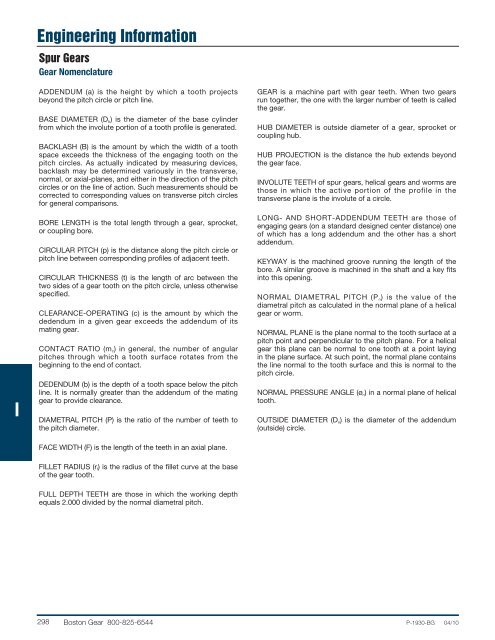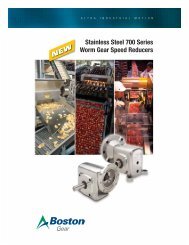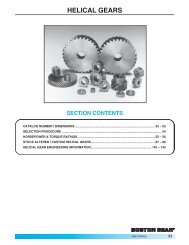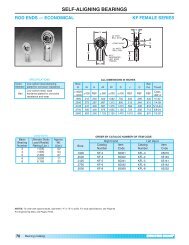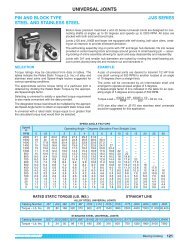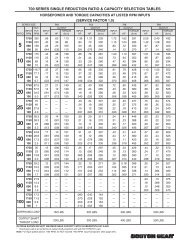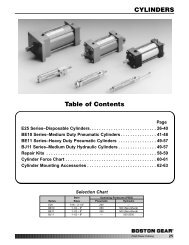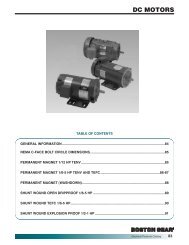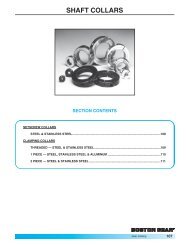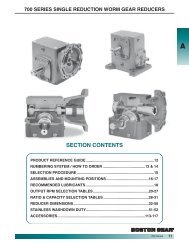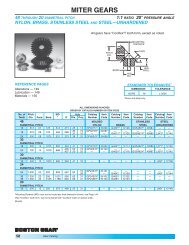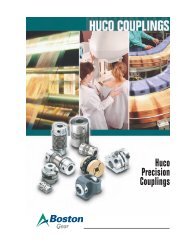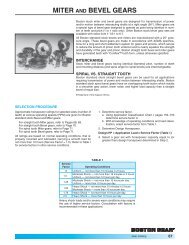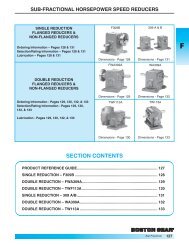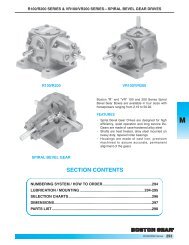Modified Stock Gearing - Boston Gear
Modified Stock Gearing - Boston Gear
Modified Stock Gearing - Boston Gear
Create successful ePaper yourself
Turn your PDF publications into a flip-book with our unique Google optimized e-Paper software.
Engineering Information<br />
Spur <strong>Gear</strong>s<br />
<strong>Gear</strong> Nomenclature<br />
I<br />
ADDENDUM (a) is the height by which a tooth projects<br />
beyond the pitch circle or pitch line.<br />
BASE DIAMETER (D b ) is the diameter of the base cylinder<br />
from which the involute portion of a tooth profile is generated.<br />
BACKLASH (B) is the amount by which the width of a tooth<br />
space exceeds the thickness of the engaging tooth on the<br />
pitch circles. As actually indicated by measuring devices,<br />
backlash may be determined variously in the transverse,<br />
normal, or axial-planes, and either in the direction of the pitch<br />
circles or on the line of action. Such measurements should be<br />
corrected to corresponding values on transverse pitch circles<br />
for general comparisons.<br />
BORE LENGTH is the total length through a gear, sprocket,<br />
or coupling bore.<br />
CIRCULAR PITCH (p) is the distance along the pitch circle or<br />
pitch line between corresponding profiles of adjacent teeth.<br />
CIRCULAR THICKNESS (t) is the length of arc between the<br />
two sides of a gear tooth on the pitch circle, unless otherwise<br />
specified.<br />
CLEARANCE-OPERATING (c) is the amount by which the<br />
dedendum in a given gear exceeds the addendum of its<br />
mating gear.<br />
CONTACT RATIO (m c ) in general, the number of angular<br />
pitches through which a tooth surface rotates from the<br />
beginning to the end of contact.<br />
DEDENDUM (b) is the depth of a tooth space below the pitch<br />
line. It is normally greater than the addendum of the mating<br />
gear to provide clearance.<br />
DIAMETRAL PITCH (P) is the ratio of the number of teeth to<br />
the pitch diameter.<br />
FACE WIDTH (F) is the length of the teeth in an axial plane.<br />
GEAR is a machine part with gear teeth. When two gears<br />
run together, the one with the larger number of teeth is called<br />
the gear.<br />
HUB DIAMETER is outside diameter of a gear, sprocket or<br />
coupling hub.<br />
HUB PROJECTION is the distance the hub extends beyond<br />
the gear face.<br />
INVOLUTE TEETH of spur gears, helical gears and worms are<br />
those in which the active portion of the profile in the<br />
transverse plane is the involute of a circle.<br />
LONG- AND SHORT-ADDENDUM TEETH are those of<br />
engaging gears (on a standard designed center distance) one<br />
of which has a long addendum and the other has a short<br />
addendum.<br />
KEYWAY is the machined groove running the length of the<br />
bore. A similar groove is machined in the shaft and a key fits<br />
into this opening.<br />
NORMAL DIAMETRAL PITCH (P n ) is the value of the<br />
diametral pitch as calculated in the normal plane of a helical<br />
gear or worm.<br />
NORMAL PLANE is the plane normal to the tooth surface at a<br />
pitch point and perpendicular to the pitch plane. For a helical<br />
gear this plane can be normal to one tooth at a point laying<br />
in the plane surface. At such point, the normal plane contains<br />
the line normal to the tooth surface and this is normal to the<br />
pitch circle.<br />
NORMAL PRESSURE ANGLE (ø n ) in a normal plane of helical<br />
tooth.<br />
OUTSIDE DIAMETER (D o ) is the diameter of the addendum<br />
(outside) circle.<br />
FILLET RADIUS (r f ) is the radius of the fillet curve at the base<br />
of the gear tooth.<br />
FULL DEPTH TEETH are those in which the working depth<br />
equals 2.000 divided by the normal diametral pitch.<br />
298 <strong>Boston</strong> <strong>Gear</strong> 800-825-6544 P-1930-BG 04/10


